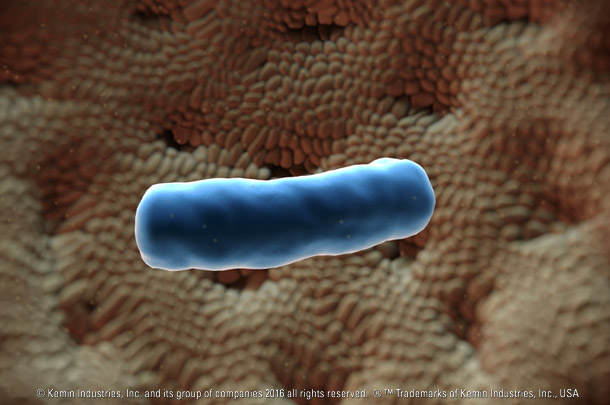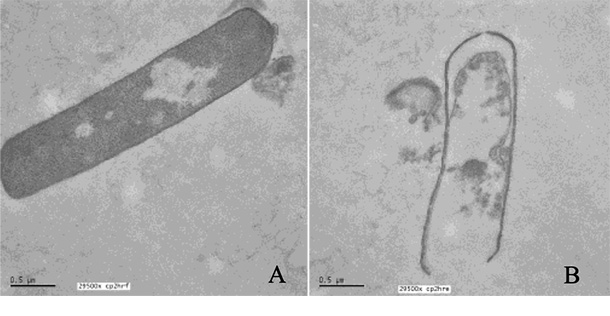From the time of a calf’s birth, bacteria begin to colonize its intestines. Not all of these bacteria are “bad” — in fact, most are beneficial. The volatile fatty acids produced by bacterial fermentation serve to lower the pH of the intestines and inhibit growth of potential pathogens. Some of the beneficial bacteria act as a barrier alongside intestinal mucosa tissue, and other bacteria even produce antimicrobial compounds to protect the cow. Balance among intestinal microflora is crucial to optimal health and production. Many environmental or management factors may disrupt the balance of intestinal bacteria in a dairy cow, such as:
- Pathogens
- Stress
- Metabolic upset
- Antibiotic use
- Commingling
Two harmful bacterial pathogens, Salmonella and Clostridium cause significant gastrointestinal problems in dairy animals, ultimately leading to economic losses and/or death loss on farms.
Salmonella
Most people are familiar with Salmonella, since it’s one of the most serious foodborne bacteria for humans in the U.S. Dairy cows are no exception, and oftentimes the on-farm presence of this damaging bacterium goes unnoticed. In a multi-state study across conventional and organic dairies, almost 90% of operations had at least one positive cow, and 5% of cultured cows were positive. Cows may not show any symptoms of Salmonella infection when shedding the bacteria through their manure, even shedding to the same degree as cows that do appear sick. Following recovery, cows may shed the organism for many months, despite showing no outward signs. Furthermore, flies, dogs, rodents and birds may also be sources of infection. Even contaminated vehicles, gates and equipment can be sources of spreading the bacteria around the farm.
During acute infection with salmonellosis, an animal will exhibit high fever; serious diarrhea, which often contains blood; and severe dehydration, which can lead to death. Prevention of this disease is incredibly important because treatment with antibiotics alone is typically not sufficient to overcome the effects of dehydration.
Clostridium
Clostridium bacteria differ from Salmonella in that they are naturally present in the gut flora of healthy cows. In other words, the mere presence of the bacteria does not pose a problem, and animal-to-animal contact does not spread clostridial diseases. Clostridium only become harmful when certain stressors provide the opportunity for overgrowth. Circumstances that are conducive to the growth of these bacteria, and subsequent release of toxins, include heat stress, dietary stress, injury, management changes and poor parasite control. Several diseases are attributed to different species of Clostridium bacteria:
- Lock jaw
- Gas gangrene
- Malignant edema
- Jejunal hemorrhage syndrome (bloody gut)
- Sudden death
- Abomasal ulcers
- Blackleg
- Red water disease
For most of these illnesses, treatment success is rare due to their aggressive nature, which makes prevention key. Many operations vaccinate against clostridial diseases; however, without a booster vaccination within six weeks, this is inadequate protection. For young calves, protection should be aimed at providing colostrum from vaccinated dams, rather than vaccination of the calves themselves.
Management prevention strategies
Often, the first response of producers to bacterial infections is antibiotic treatment. However, consumer concern about use of antibiotics on farms has limited this treatment option now and into the future. In addition, some species of Salmonella are resistant to multiple antibiotics and Clostridium bacteria will often kill an animal before intervention can take place.
The most prudent method for protecting dairy operations against Clostridium and Salmonella is proper health management before disease hits. The management strategies for prevention of gastrointestinal insult from these pathogens include:
- Separation of sick, treated or cull cows from fresh cows
- Inclusion of ionophores in weaned calf or bred heifer diets
- Rodent control
- Consistent feeding practices
- Vaccination where applicable
- Appropriate storage and fermentation of silage
- Short-term use of calving area, by calving cows only
- Sanitary conditions for colostrum feeding
- Limited antibiotic use
- Maintenance of healthy gut flora by inclusion of a direct-fed microbial (DFM) in the diet
Choosing a strain
When choosing a DFM, it’s important to consider the strain and its activity in the intestinal environment based on research. Some products may contain multiple strains of organisms, making it difficult to ascertain which strain is responsible for the positive effects. Research conducted on individual strains can help you choose a product that will target the desired benefits for your operation. A few examples of DFM strains supplemented to ruminants are Lactobacillus acidophilus, L. lactis, L. plantarum, Enterococcus faecium and Bacillus subtilis.
B. subtilis PB6 for aiding in the prevention of salmonellosis and clostridial diseases
CLOSTAT® contains a proprietary, patented strain of B. subtilis PB6. PB6 is a unique, naturally occurring, spore-forming microorganism. Kemin has identified and selected PB6 as an active substance that helps maintain the balance of microflora in the intestinal tract of livestock (Figure 1). Figure 2 demonstrates the inhibition of Clostridium perfringens by PB6.
In vitro research conducted on B. subtilis PB6 has shown antagonistic activity toward clostridial isolates from poultry, swine and equine sources. Recently, weaned Holstein steer calves were supplemented with PB6 in a starter ration for 35 days, prior to a Salmonella enterica serovar Typhimurium challenge. Calves that received the DFM displayed lower rectal temperatures and significantly reduced Salmonella concentrations in portions of the intestinal tract 96 hours post-challenge compared to calves that did not receive the PB6.
CLOSTAT is stable when blended with other feed ingredients and under normal commercial pelleting conditions.
Conclusions and practical application
Maintaining gut health in your dairy herd is vital to optimal performance. Adding CLOSTAT to your rations can help balance the intestinal flora of your animals and aid in the prevention of potentially harmful pathogens like Clostridium and Salmonella. As the industry moves toward less antibiotic use, consider feeding safe alternatives like CLOSTAT to maintain and improve cow health and performance.

Figure 1: B. subtilis PB6 in the intestine

Figure 2: (A) C. perfringens before adding PB6 extract (B) C. perfringens after adding PB6 extract
For more information about Kemin Animal Nutrition & Health research in dairy cattle and other species, contact your Kemin representative or visit Kemin.com/Ag.
References are available upon request by contacting KeminAg@kemin.com.



